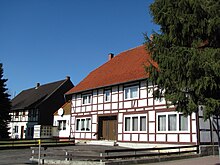Hackenstedt
|
Hackenstedt
Holle municipality
|
|
|---|---|
| Coordinates: 52 ° 4 ′ 32 ″ N , 10 ° 6 ′ 20 ″ E | |
| Height : | approx. 150 m |
| Residents : | 462 (Nov. 30, 2017) |
| Incorporation : | March 1, 1974 |
| Postal code : | 31188 |
| Area code : | 05062 |
Hackenstedt is a village in the municipality of Holle in the district of Hildesheim in the German state of Lower Saxony .
location
Hackenstedt is in the Harz foreland on the K 309 district road between the Hildesheimer Börde and the Wohldenberg . The proximity to the motorways 7 and 39 as well as the B 6 and B 243 ensure good transport connections. Bus connections or the Derneburg train station are available as public transport.
politics
After the municipal elections in Lower Saxony in 2016 , the five seats in the local council are distributed as follows (changes to the 2011 election in brackets ):
coat of arms
As with the Derneburg coat of arms , the abbot Arnu of the Derneburg monastery can be associated with the Hackenstedter coat of arms. Under his direction, a tithing barn made of rubble stones was built in 1727 on the site of the dilapidated half-timbered barn on the south side of the village, into which the people of Hackenstedt had to deliver their grain, fallow and meat tithes. This barn now adorns the Hackenstedt coat of arms.
history
The meaning of the name Hackenstedt refers to the location of the place, as Hau or Hav denotes a place where the forest has been cut. Even today, the remote village with its field marrow is enclosed by the forest, so that an overview of its location is only possible from Söder .
On the southern edge of the village, the Zehntscheune stands as a landmark of Hackenstedt, which consists of quarry stones and was built by the building abbot Arnu of the Derneburg monastery in 1727. The monument indicates the influence of the neighboring monastery, which incorporated most of the Hackenstedter estates between 1229 and 1481.
Before that, the property belonged partly to the Wohldenberg counts , partly to the von Steinberg and von Berkefeld families, who had received it as a fief from the Hildesheim bishop . In 1334 the knights Berthold and Heinrich renounced the patronage of the Hackenstedt Church and handed it over to the Derneburg Monastery .
Since 1730 the parish has been combined with Sottrum , and due to the expansion of the parish, the church was rebuilt in 1731 in the baroque style. Only the massive tower with its small slits of light is from an older time.
The primary school in Hackenstedt dates from 1719, a second school building from 1803 burned down completely due to flying sparks in 1844. In the same year today's school was built, which was rebuilt and enlarged in 198. In 1924 the community built a community school for both denominations, which was dissolved with the construction of a central school and converted into a kindergarten.
Since 1815 the owner of Derneburg , the Count of Münster , was the landlord in Hackenstedt. These basic rights were redeemed in 1840 by the Hackenstedt farmers with an amount of 15,300 thalers. The subsequent coupling lasted from 1854 to 1865 and could only be successfully completed after lengthy negotiations with the Söder and Derneburg estates .
The first water pipe in Hackenstedt was built in 1911 with water from the forest that covered the needs of the place. In 1934 a pumping station was built in the village and in 1968 an elevated tank. The construction of the new housing estates began in 1953 and in the 1970s a farmer opened up a large settlement which he later sold to the community.
During the Second World War, Hackenstedt lost 42 of the 100 drafted soldiers, in whose honor a memorial plaque was placed in the church.
The men's choir founded in 1877 and the Hackenstedt wind corps from 1967 have made Hackenstedt known far beyond Holle's borders through numerous activities and events.
On March 1, 1974, Hackenstedt was incorporated into the municipality of Holle.
Attractions
- Tithe barn from 1727
- Numerous well-preserved half-timbered houses
- The Protestant Pauluskirche was built in 1731 in the baroque style. It has a late Romanesque west tower with a gable roof and an additional roof turret . The nave with its half-hip roof was rebuilt in 1751/52. Inside - apart from the vaulted wooden ceiling painted by GE Fabricius and EH Löhr in 1751 - the baroque pulpit altar (designed in 1734 by the Bockenem artist JH Varenholz) with its colorful wood carvings and several statues also carved from wood is striking. There is no baptismal font in the church. Instead, it has a baptismal angel from 1734, attached to the ceiling to the left of the altar and holding a shell in his hand. During baptisms, a vessel with water is placed in the shell.
Infrastructure
Hackenstedt has a kindergarten, but no longer a school. There was a restaurant in the middle of the village.
Transport links
There are direct bus connections to Hildesheim , Derneburg train station and Seesen several times a day on weekdays . Via the neighboring Söder you can reach the federal highway 243, which leads to Bad Salzdetfurth and Bockenem .
Web links
Individual evidence
- ↑ Population figures in the districts of the municipality of Holle , accessed on December 27, 2017
- ^ Website of the municipality of Holle , accessed on October 1, 2016.
- ^ Federal Statistical Office (ed.): Historical municipality directory for the Federal Republic of Germany. Name, border and key number changes in municipalities, counties and administrative districts from May 27, 1970 to December 31, 1982 . W. Kohlhammer GmbH, Stuttgart and Mainz 1983, ISBN 3-17-003263-1 , p. 210 .




